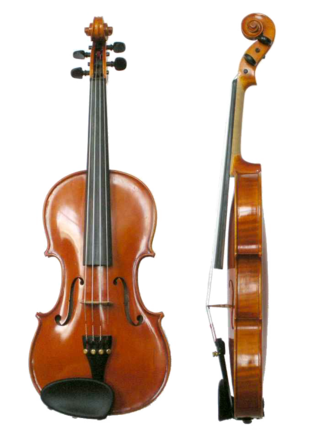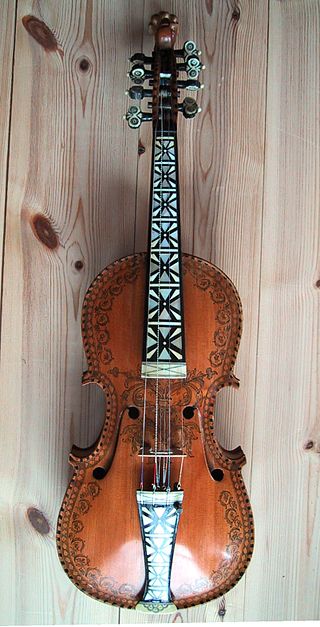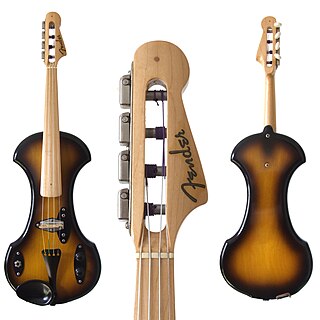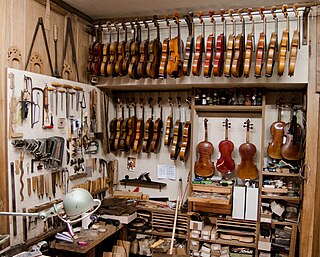
The cello ( CHEL-oh), or violoncello ( VY-ə-lən-CHEL-oh, Italian pronunciation:[vjolonˈtʃɛllo]), is a bowed (sometimes plucked and occasionally hit) string instrument of the violin family. Its four strings are usually tuned in perfect fifths: from low to high, C2, G2, D3 and A3. The viola's four strings are each an octave higher. Music for the cello is generally written in the bass clef, with tenor clef, and treble clef used for higher-range passages.

The double bass, also known as the upright bass for distinguishing purposes, or simply as the bass, is the largest and lowest-pitched chordophone, in the modern symphony orchestra. Similar in structure to the cello, it has four or five strings.

The violin, sometimes known as a fiddle, is a wooden chordophone in the violin family. Most violins have a hollow wooden body. It is the smallest and thus highest-pitched instrument (soprano) in the family in regular use. The violin typically has four strings, usually tuned in perfect fifths with notes G3, D4, A4, E5, and is most commonly played by drawing a bow across its strings. It can also be played by plucking the strings with the fingers (pizzicato) and, in specialized cases, by striking the strings with the wooden side of the bow.

The viola ( vee-OH-lə, Italian:[ˈvjɔːla,viˈɔːla]) is a string instrument that is usually bowed or plucked. Slightly larger than a violin, it has a lower and deeper sound. Since the 18th century, it has been the middle or alto voice of the violin family, between the violin (which is tuned a perfect fifth higher) and the cello (which is tuned an octave lower). The strings from low to high are typically tuned to C3, G3, D4, and A4.

In musical instrument classification, string instruments or chordophones, are musical instruments that produce sound from vibrating strings when a performer plays or sounds the strings in some manner.

Pizzicato is a playing technique that involves plucking the strings of a string instrument. The exact technique varies somewhat depending on the type of instrument:

The rebec is a bowed stringed instrument of the Medieval era and the early Renaissance. In its most common form, it has a narrow boat-shaped body and one to five strings.

The hurdy-gurdy is a string instrument that produces sound by a hand-crank-turned, rosined wheel rubbing against the strings. The wheel functions much like a violin bow, and single notes played on the instrument sound similar to those of a violin. Melodies are played on a keyboard that presses tangents—small wedges, typically made of wood or metal—against one or more of the strings to change their pitch. Like most other acoustic stringed instruments, it has a sound board and hollow cavity to make the vibration of the strings audible.

A mute is a device attached to a musical instrument which changes the instrument's tone quality (timbre) or lowers its volume. Mutes are commonly used on string and brass instruments, especially the trumpet and trombone, and are occasionally used on woodwinds. Their effect is mostly intended for artistic use, but they can also allow players to practice discreetly. Muting can also be done by hand, as in the case of palm muting a guitar or grasping a triangle to dampen its sound.

The erhu is a Chinese two-stringed bowed musical instrument, more specifically a spike fiddle, which may also be called a Southern Fiddle, and is sometimes known in the Western world as the Chinese violin or a Chinese two-stringed fiddle.
Scordatura is a tuning of a string instrument that is different from the normal, standard tuning. It typically attempts to allow special effects or unusual chords or timbre, or to make certain passages easier to play. It is common to notate the finger position as if played in regular tuning, while the actual pitch resulting is altered. When all the strings are tuned by the same interval up or down, as in the case of the viola in Mozart's Sinfonia Concertante for Violin, Viola and Orchestra, the part is transposed as a whole.

A Hardanger fiddle is a traditional stringed instrument considered to be the national instrument of Norway. In modern designs, this type of fiddle is very similar to the violin, though with eight or nine strings and thinner wood. The F-holes of the Hardanger fiddle are distinctive, oftentimes with a more "sunken" appearance, and generally straighter edges. Four of the strings are strung and played like a violin, while the rest, named understrings or sympathetic strings, resonate under the influence of the other four. These extra strings are tuned and secured with extra pegs at the top of the scroll, effectively doubling the length of a Hardingfele scroll when compared to a violin. The sympathetic strings, once fastened to their pegs, are funneled through a "hollow" constructed fingerboard, which is built differently than a violin's, being slightly higher and thicker to allow for these extra strings. The resonant strings lie on the center of the special bridge, attached to extra hooks on the tailpiece. Carved out within the center of the bridge is a smaller secondary "bridge", or opening, designed specifically for these resonant strings to pass through. This is where the resonance is picked up and reverberated; as notes are played, the vibrations are sent through the bridge, where the sympathetics echo those notes.

The Appalachian dulcimer is a fretted string instrument of the zither family, typically with three or four strings, originally played in the Appalachian region of the United States. The body extends the length of the fingerboard, and its fretting is generally diatonic.

An electric violin is a violin equipped with an electronic output of its sound. The term most properly refers to an instrument intentionally made to be electrified with built-in pickups, usually with a solid body. It can also refer to a violin fitted with an electric pickup of some type, although "amplified violin" or "electro-acoustic violin" are more accurate then.

A Baroque violin is a violin set up in the manner of the baroque period of music. The term includes original instruments which have survived unmodified since the Baroque period, as well as later instruments adjusted to the baroque setup, and modern replicas. Baroque violins have become relatively common in recent decades thanks to historically informed performance, with violinists returning to older models of instrument to achieve an authentic sound.

Making an instrument of the violin family, also called lutherie, may be done in different ways, many of which have changed very little in nearly 500 years since the first violins were made. Some violins, called "bench-made" instruments, are made by a single individual, either a master maker or an advanced amateur, working alone. Several people may participate in the making of a "shop-made" instrument, working under the supervision of a master. This was the preferred method of old violin makers who always put their names on violins crafted by their apprentices. Various levels of "trade violin" exist, often mass-produced by workers who each focus on a small part of the overall job, with or without the aid of machinery.

Playing the violin entails holding the instrument between the jaw and the collar bone. The strings are sounded either by drawing the bow across them (arco), or by plucking them (pizzicato). The left hand regulates the sounding length of the strings by stopping them against the fingerboard with the fingers, producing different pitches.

Acoustic music is music that solely or primarily uses instruments that produce sound through acoustic means, as opposed to electric or electronic means. While all music was once acoustic, the retronym "acoustic music" appeared after the advent of electric instruments, such as the electric guitar, electric violin, electric organ and synthesizer. Acoustic string instrumentations had long been a subset of popular music, particularly in folk. It stood in contrast to various other types of music in various eras, including big band music in the pre-rock era, and electric music in the rock era.

The bladder fiddle was a folk instrument used throughout Europe and in the Americas. The instrument was originally a simple large stringed fiddle made with a long stick, one or more thick gut strings, and a pig's-bladder resonator. It was bowed with either a notched stick or a horsehair bow.

The Nepali Sarangi is a Nepali folk instrument. It is a chordophone played by bowing. Traditionally in Nepal, the Sarangi was only played by people of Gandarbha or Gaine caste, who sing narrative tales and folk song, however, in present days, its popularity extends beyond the Gandharba community and is widely used and played by other caste members as well. It has also garnered much interest in other music genres, such as Nepali rock and film music. While the Sarangi has become the quintessential Gandharba instrument, while its counterpart, the arbajo, which is a plucked lute, has fallen into obscurity.



















